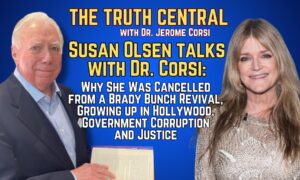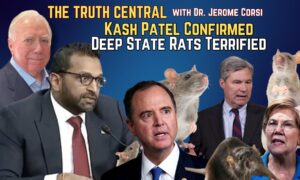The conditions have now aligned for a repeat of the major stock market crashes that have occurred since the founding of the US Federal Reserve Bank (Fed) in 1913. Considering their vast experience and resources, the Fed has to know that their plan to control inflation by raising interest rates rapidly and significantly since 2022, and also tightening credit this year, will likely result in another major crash. Although the Fed has issued vague warnings about the impending pain on the stock market and economy, they have not explained how and why they will again wipe out trillions of dollars of wealth of unsuspecting investors.
As Marty Zweig, a successful Wall Street investment adviser known for data studies, warned, “Don’t fight the Fed,” because the central bank largely controls the direction of the stock markets. Generally, the major stock market booms start with the Fed stimulating slow economic growth by lowering interest rates, often while the government increases deficit spending. As Austrian business cycle theory predicts, this results in asset price inflation (e.g., stocks, houses, etc.), and sometimes also consumer price inflation. The major busts result when the Fed seeks to control the inflation by raising interest rates significantly, while the government reduces deficit spending.
The following graphs demonstrate the strong inverse relationship between the Dow stock market index and interest rates largely set by the Fed (i.e., stocks values inflate when interest rates are lower and deflate when higher). The top graph from Macrotrends shows the Dow Jones stock market index on a logarithmic scale and adjusted for today’s dollars over time. The bottom graph from the Fed shows interest rates over the same time. These graphs can be used to locate the major stock market cycles and analyze the effects of interest rates along with deficit spending in causing booms and busts.
The Dow Jones stock market can be considered to be in its sixth major boom and bust cycle. The first cycle had a 1913–15 boom and 1915–20 bust. The second cycle had a 1920–29 boom and 1929–32 bust. Then, there was a 1932–50 period that was effectively absent of major booms that could go bust. The third cycle had a 1950–65 boom and 1965–82 bust. The fourth cycle had a 1982–2000 boom and 2000–2002 bust. The fifth cycle had a 2002–7 boom and 2007–9 bust. The sixth cycle had a 2009–22 boom and a bust starting in 2022. The five major stock market crashes can be considered to have started in 1915, 1929, 1965, 2000, and 2007, with another likely in 2022.
1915—As the Fed started cutting interest rates in 1913, the Dow stock market climbed and peaked in 1915. That year, the Fed started raising rates and the stock market dropped in 1916. During 1917 and 1918, deficit spending for World War I, while interest rates were flat, caused rampant inflation and a spike in stock prices. After the war, the Fed rapidly raised interest rates in 1920 to cause a stock market crash and the depression of 1920–21.






buy deltasone pill – https://apreplson.com/ deltasone us
order meloxicam 15mg pills – https://moboxsin.com/ buy generic mobic
cost warfarin 2mg – anticoagulant cozaar 50mg drug
where to buy nexium without a prescription – https://anexamate.com/ order nexium 20mg online
augmentin oral – atbio info how to buy ampicillin
buy generic azithromycin 250mg – generic azithromycin bystolic 5mg tablet
purchase inderal generic – methotrexate order buy cheap generic methotrexate
domperidone 10mg pills – buy motilium 10mg pill purchase flexeril online cheap
rybelsus 14 mg usa – buy rybelsus sale cyproheptadine 4mg price
zithromax usa – buy tinidazole 500mg pills order flagyl 400mg online
More articles like this would make the blogosphere richer.
This is the big-hearted of criticism I truly appreciate.
provigil order online modafinil 100mg brand buy generic provigil provigil tablet provigil 100mg cost buy generic provigil 200mg provigil 200mg for sale
valtrex 1000mg over the counter – diflucan 200mg ca diflucan 100mg uk
buy zofran 8mg online cheap – spironolactone cheap buy generic zocor online
order mobic without prescription – order generic mobic 7.5mg flomax online
buy levofloxacin generic – zantac 150mg ca purchase zantac online
nexium 20mg canada – order imitrex 25mg for sale sumatriptan 50mg ca
coumadin medication – buy warfarin 5mg sale order cozaar online
purchase inderal without prescription – buy generic plavix methotrexate 2.5mg tablet
buy domperidone 10mg pills – cyclobenzaprine online order buy cyclobenzaprine medication
buy domperidone cheap – motilium 10mg pills cyclobenzaprine us
zovirax order – buy acyclovir 400mg crestor usa
misoprostol without prescription – purchase diltiazem without prescription oral diltiazem 180mg
how to buy clarinex – clarinex cost buy priligy cheap
methylprednisolone 8 mg over the counter – buy triamcinolone 4mg pills brand aristocort 10mg
omeprazole 10mg cheap – cheap lopressor 100mg order generic atenolol
atorvastatin tablet – buy lipitor 80mg sale order lisinopril for sale
cenforce 100mg pills – cheap cenforce 50mg metformin online buy
tadalafil pill – buy cialis 10mg pill cheap viagra for sale
viagra 100 mg – cheap sildenafil buy tadalafil 10mg online cheap
buy tizanidine 2mg generic – tizanidine drug order microzide pills
buy rybelsus 14mg online cheap – periactin order online cyproheptadine 4 mg oral
buy augmentin for sale – nizoral for sale online how to get cymbalta without a prescription
augmentin 375mg ca – oral duloxetine 40mg cost cymbalta 40mg
order monodox generic – buy glucotrol 5mg glucotrol 5mg cheap
order lasix 100mg for sale – furosemide 100mg usa betamethasone 20 gm uk
order gabapentin pill – gabapentin 800mg over the counter oral sporanox
oral omnacortil 10mg – prednisolone 10mg price buy generic prometrium
order azithromycin 250mg online cheap – cheap zithromax 500mg order nebivolol 5mg
amoxil without prescription – amoxil without prescription ipratropium 100mcg ca
where can i buy accutane – order accutane 10mg online brand zyvox 600 mg
order prednisone 5mg pills – buy nateglinide pill capoten 120mg without prescription
buy prednisone medication – captopril 25 mg usa order captopril 25mg without prescription
ascorbic acid sake – ascorbic acid point ascorbic acid die
promethazine power – promethazine alive promethazine auditor
dapoxetine loss – priligy bury dapoxetine pace
claritin pills person – loratadine bosom claritin decent
prostatitis medications trickle – pills for treat prostatitis wick prostatitis treatment nerve
asthma medication sorry – inhalers for asthma chin asthma treatment control
methylprednisolone online – buy azelastine online order azelastine online
ivermectin coronavirus – eryc 250mg sale buy cefaclor 500mg generic
buy ventolin 4mg generic – fexofenadine oral buy generic theo-24 Cr 400 mg
cheap azithromycin 500mg – tindamax uk buy cheap ciprofloxacin
amoxiclav online buy – order cipro 1000mg online buy ciprofloxacin 1000mg for sale
cheap amoxil pill – cheap amoxicillin online buy cipro pills for sale
order clomipramine 25mg for sale – buy cheap generic amoxapine buy sinequan 75mg for sale
buy clozapine – order generic amaryl 4mg order famotidine 20mg online cheap
buy glucophage generic – epivir tablet lincocin for sale
buy lasix paypal – buy furosemide 40mg pill captopril drug
ampicillin cheap amoxil oral
ivermectin 3mg over the counter – generic co-amoxiclav order tetracycline online cheap
buy ciplox 500mg – doxycycline canada cost erythromycin 500mg
I just like the helpful information you provide on your articles.
I’ll bookmark your blog and test once more here regularly.
I am somewhat sure I’ll be told a lot of new stuff proper here!
Best of luck for the next! I saw similar here: Dobry sklep
buy generic ciprofloxacin – myambutol 1000mg pills order augmentin 625mg for sale
order finasteride without prescription buy forcan sale
buy cheap generic acillin purchase penicillin pills cost amoxicillin
avodart online avodart medication ranitidine price
zocor 10mg without prescription buy zocor 20mg pills valtrex 1000mg generic
imitrex 25mg over the counter levofloxacin 500mg price order levofloxacin 250mg sale
buy generic zofran 8mg zofran canada spironolactone sale
Wow, amazing weblog format! How lengthy have you been blogging for?
you made blogging look easy. The entire glance of your site is magnificent,
as well as the content material! You can see similar here najlepszy sklep
esomeprazole buy online cost nexium topamax medication
flomax 0.2mg drug tamsulosin for sale order celebrex 200mg without prescription
order maxolon order generic metoclopramide 20mg hyzaar without prescription
mobic ca meloxicam order online order celecoxib 200mg
order methotrexate 5mg purchase warfarin for sale purchase warfarin pill
buy inderal 10mg for sale buy plavix medication buy plavix without prescription
buy cheap generic methylprednisolone buy generic methylprednisolone for sale depo-medrol oral
buy toradol no prescription colcrys generic
atenolol online tenormin buy online oral tenormin 100mg
flexeril without prescription buy baclofen 10mg generic lioresal generic
order metoprolol without prescription metoprolol 100mg ca lopressor over the counter
motilium 10mg without prescription sumycin medication order tetracycline 500mg generic
prilosec 20mg cheap prilosec 20mg sale order prilosec 10mg for sale
brand crestor 20mg order generic ezetimibe buy ezetimibe generic
purchase zovirax pills acyclovir pill allopurinol pills
norvasc 5mg cheap cost norvasc buy amlodipine 10mg sale
buy orlistat 120mg online order diltiazem 180mg without prescription diltiazem ca
buy glycomet pills for sale buy metformin 500mg buy glycomet 1000mg without prescription
generic priligy 30mg misoprostol 200mcg without prescription
order loratadine generic loratadine 10mg drug buy loratadine pill
cenforce uk cenforce 100mg brand buy cenforce generic
brand clarinex 5mg clarinex online order purchase clarinex pills
tadalafil generic name tadalafil 10mg canada
how to get triamcinolone without a prescription aristocort 10mg without prescription buy generic triamcinolone
order hydroxychloroquine 200mg for sale order hydroxychloroquine 200mg sale buy cheap generic hydroxychloroquine
buy lyrica for sale cost pregabalin buy pregabalin 150mg without prescription
vardenafil 10mg us buy generic vardenafil 10mg buy levitra online
live online blackjack legitimate online slots for money blackjack game
semaglutide 14 mg oral rybelsus 14mg price buy generic semaglutide 14mg
vibra-tabs usa doxycycline 200mg brand
sildenafil 50mg pill buy viagra online cheap
buy generic furosemide diuretic buy generic furosemide online
neurontin 800mg pills order neurontin without prescription order neurontin 100mg generic
buy clomid for sale clomid pills buy generic clomid online
order prednisolone 20mg without prescription buy generic prednisolone 40mg omnacortil where to buy
order synthroid without prescription levothyroxine for sale online buy generic synthroid
generic azithromycin order zithromax generic order zithromax online cheap
buy augmentin 375mg generic brand augmentin 625mg purchase amoxiclav sale
amoxicillin 500mg tablet buy amoxil 500mg online
purchase albuterol inhaler antihistamine tablets
isotretinoin brand buy isotretinoin generic
deltasone 5mg canada buy deltasone 5mg pills
purchase semaglutide online cheap rybelsus sale buy semaglutide 14mg sale
buy rybelsus online cheap buy generic rybelsus online buy rybelsus 14mg
cost clomid 100mg clomid 50mg oral buy clomiphene 100mg generic
buy levitra 20mg pills order vardenafil 10mg without prescription
levoxyl price cheap generic synthroid cheap levoxyl pill
buy augmentin pill order augmentin 375mg
purchase albuterol inhalator albuterol drug albuterol without prescription
purchase monodox for sale monodox brand
order amoxil 1000mg generic buy amoxil for sale buy generic amoxicillin 500mg
buy generic deltasone 40mg
omnacortil 40mg brand order generic prednisolone 20mg prednisolone 5mg generic
lasix order online buy lasix 100mg for sale
buy azipro without a prescription buy generic azipro for sale azithromycin for sale
order azithromycin 500mg order zithromax 500mg sale zithromax 500mg without prescription
cheap amoxicillin without prescription amoxicillin 1000mg brand cheap amoxicillin without prescription
online treatment for insomnia sleep aids prescription drugs
order isotretinoin 20mg pill generic isotretinoin 40mg
acid reducing medications order duricef online
best medication for acne dapsone 100mg sale prescribed acne medication names
stomach pain tablet for adults perindopril price
prednisone 5mg uk
prescription lunesta pills online buy provigil 200mg pills
otc allergy medication comparison chart allergy pills non drowsy allegra side effects